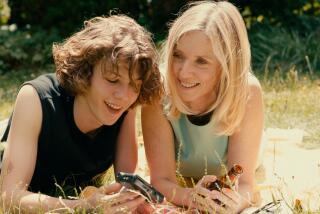A Second Look: ‘Chronicle of a Summer’ a snapshot of 1960 Paris
- Share via
As its title suggests, the seminal French film “Chronicle of a Summer” is a time capsule of a particular moment: Paris in 1960, the Algerian War entering its sixth year, the Holocaust still a recent wound, popular and consumer culture on the rise, and, especially among the younger population, clear signs of the discontent and frustration that would define the tumultuous decade to come.
A collaboration between the anthropologist-filmmaker Jean Rouch and the sociologist Edgar Morin, “Chronicle” takes shape as a panoramic, state-of-the-nation survey. It opens with a series of on-the-street interviews, in which Parisians are stopped and asked a simple, endlessly provocative question: “Are you happy?”
But the film, which has finally made its long overdue DVD debut thanks to the Criterion Collection, also marks a turning point in the medium. An introductory voice-over announces that we are about to witness an experiment in “cinéma vérité.” The phrase, which would eventually be used to describe a movement and even a style of filmmaking, is a translation of “kino pravda” (“film truth”), a term associated with the Soviet pioneer Dziga Vertov, who radicalized cinema in the 1920s with such films as “Man With a Movie Camera.”
PHOTOS: Celebrity portraits by The Times
“Chronicle of a Summer” makes use of newly available equipment: lightweight 16-millimeter cameras and synchronous-sound technology. But it also raises timeless questions about the nature of filmed truth, which have vexed and inspired filmmakers since the infancy of cinema and which remain unresolved to this day.
Morin, one of France’s most prominent public intellectuals at the time, had been a member of the Communist Party and was a vocal opponent of the Algerian War. Rouch, a former engineer, had worked for years in West Africa, producing acclaimed ethnographic films that often emphasized the cultural collisions involved in documenting the traditions and rituals of his subjects. “Chronicle of a Summer” tries to turn the camera on their own tribe as they navigate a period of upheaval.
After the flurry of vox-pop sound bites, the film settles in for more detailed, close-range portraiture of a handful of subjects: a concentration camp survivor, a factory worker, a middle-class couple, students from Africa, a young woman from Italy who works as a secretary for the magazine Cahiers du Cinéma.
But Morin and Rouch do not stop at interviewing their protagonists about their lives. They install themselves as participants and instigators, sometimes appearing on camera and bringing their subjects together in group settings.
“Chronicle of a Summer” builds to a sequence in which Morin and Rouch show a rough cut to their participants and film their responses to the footage. Instead of the mutual understanding and productive debate they had hoped for, the discussion devolves into second-guessing and bickering over questions of performance and authenticity. Initially, the filmmakers took this reaction as proof of their failure (the screening scene was omitted from early cuts). But as they obviously realized, this built-in auto-critique is crucial to the film’s meaning.
In the epilogue Morin and Rouch pace the halls of the Musée de l’Homme in Paris, recapping and analyzing their experiment and its aftermath. Their subjects were variously blamed for being “too true” or “not true enough,” for being exhibitionists or phonies. But the filmmakers’ hypothesis is that the moments they have captured on film are no less true, or at least no less revealing, for being acted. How we act, in other words, reveals something about who we are.
PHOTOS: Hollywood Backlot moments
The spontaneity and mobility of “Chronicle of a Summer” — most apparent in the outdoor scenes, such as the one in which the camera follows a young woman as she traverses the expanse of the Place de la Concorde — would resonate with the upstarts of the French New Wave, who were themselves taking to the streets for their fiction films. (One of “Summer’s” cinematographers, Raoul Coutard, worked with Godard and Truffaut and was one of the New Wave’s key figures.)
The film’s insights about life’s theatrical aspects find fuller expression in the work of John Cassavetes and Jacques Rivette (who can be glimpsed in “Chronicle of a Summer” as a new boyfriend of one of the subjects).
“Nous sommes dans le bain,” Morin tells Rouch in the film’s last line. Translated in previous versions as “We’re in trouble,” the expression is rendered in the Criterion edition as “We’re in it.” A founding work of the vérité movement that encapsulates both its potential and its pitfalls, “Chronicle of a Summer” ends on a fitting note of caution by acknowledging it has opened a can of worms.
PHOTOS AND MORE
TIMELINE: Violence in movies
ENVELOPE: The latest awards buzz
PHOTOS: Greatest box office flops
More to Read
Only good movies
Get the Indie Focus newsletter, Mark Olsen's weekly guide to the world of cinema.
You may occasionally receive promotional content from the Los Angeles Times.







